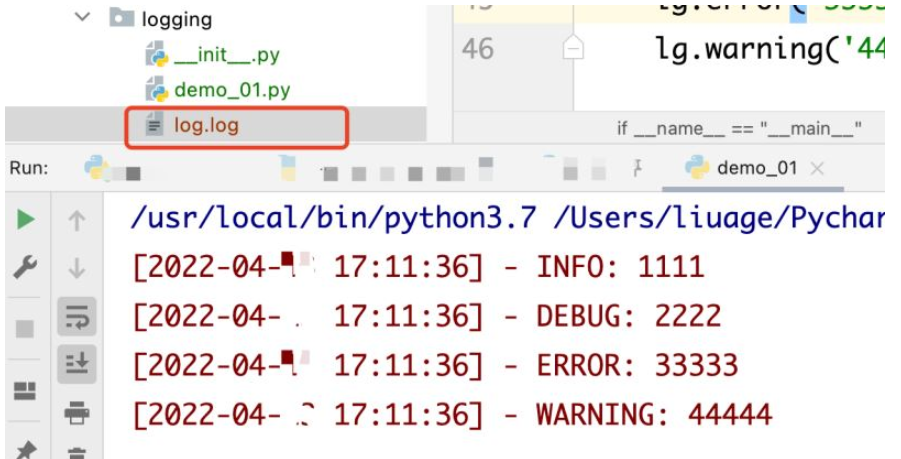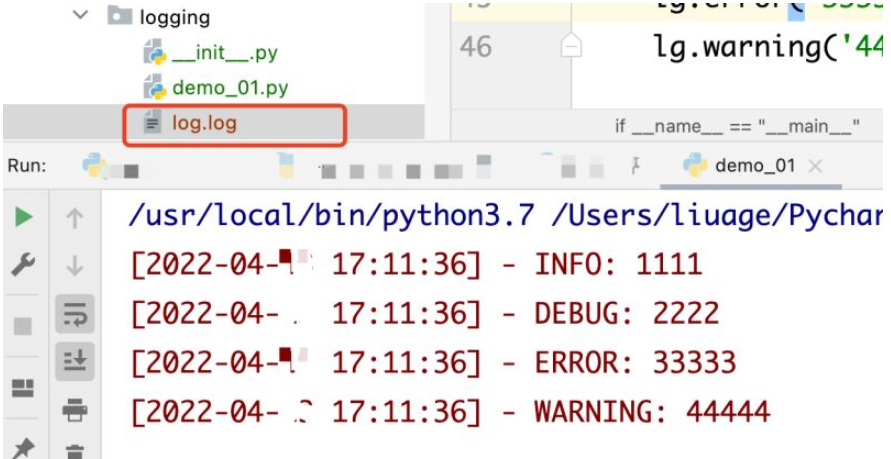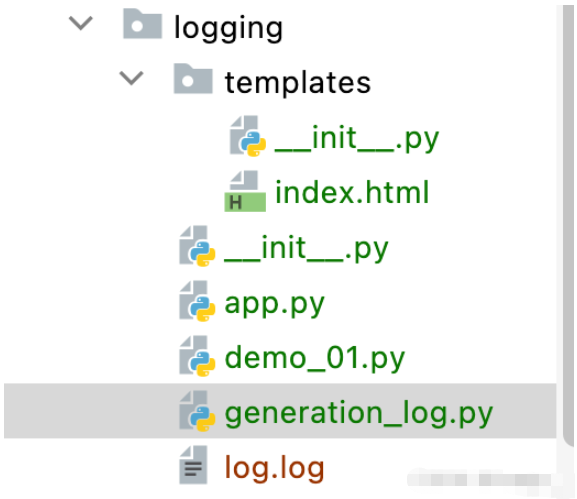 Backend Development
Backend Development
 Python Tutorial
Python Tutorial
 How to use python+Flask to realize real-time update and display of logs on web pages
How to use python+Flask to realize real-time update and display of logs on web pages
How to use python+Flask to realize real-time update and display of logs on web pages
May 17, 2023 am 11:07 AM1. Output logs to files
Use module: logging
You can generate custom level logs and output logs to the specified path
Log level: debug (debug log)
1. Encapsulation log Output method ()
import logging as lg
import os
class logging_():
def __init__(path,delete=True)
self.path = path #日志文件存放位置
name = 'log.log' #日志文件名稱
self.log_ = os.path.join(self.path,name) #進(jìn)入文件目錄
if delete == True:
open(f"{path}/{name}","w").close #為True時(shí)清空文本
# 創(chuàng)建一個(gè)日志處理器
self.logger = lg.getLogger('logger')
# 設(shè)置日志等級(jí),低于設(shè)置等級(jí)的日志被丟棄
self.logger.setLevel(lg.DEBUG)
# 設(shè)置輸出日志格式
self.fmt = lg.Formatter("[%(asctime)s] - %(levelname)s: %(message)s","%Y-%m-%d %H:%M:%S")
# 創(chuàng)建一個(gè)文件處理器
self.fh = lg.FileHandler(self.log_,encoding='utf-8')
# 設(shè)置文件輸出格式
self.fh.setFormatter(self.fmt)
# 將文件處理器添加到日志處理器中
self.logger.addHandler(self.fh)
# 創(chuàng)建一個(gè)控制臺(tái)處理器
self.sh=lg.StreamHandler()
# 設(shè)置控制臺(tái)輸出格式
self.sh.setFormatter(self.fmt)
# 將控制臺(tái)處理器添加到日志處理器中
self.logger.addHandler(self.sh)
# 關(guān)閉文件
self.fh.close()
# 使用
if __name__ == '__main__':
_path = os.paht.dirname(__file__) # 獲取當(dāng)前文件的路徑
lg = logging_(_path).logger # 實(shí)例化封裝類
lg.info('1111')
lg.debug('2222')
lg.error('33333')
lg.warning('44444')Output content after running, there is an additional log.log file in the current file directory:

Log content:

2. Generate logs and read logs
1. Create a new py file (generation_log) with a customized file name.
2. Directly upload Code
# 導(dǎo)入上面封裝好的日志輸出
from logging.demo_01 import logging_
import os,time
_path = os.path.dirname(__file__) # 獲取當(dāng)前文件路徑
lg = logging_(_path) # 實(shí)例化類
# 創(chuàng)建方法生成日志
def generation_log():
for i in range(20):
lg.info(i)
time.sleep(1)
# 讀取日志并返回
def red_logs():
log_path = f'{_path}/log.log' # 獲取日志文件路徑
with open(log_path,'rb') as f:
log_size = path.getsize(log_path) # 獲取日志大小
offset = -100
# 如果文件大小為0時(shí)返回空
if log_size == 0:
return ''
while True:
# 判斷offset是否大于文件字節(jié)數(shù),是則讀取所有行,并返回
if (abs(offset) >= log_size):
f.seek(-log_size, 2)
data = f.readlines()
return data
# 游標(biāo)移動(dòng)倒數(shù)的字節(jié)數(shù)位置
data = f.readlines()
# 判斷讀取到的行數(shù),如果大于1則返回最后一行,否則擴(kuò)大offset
if (len(data) > 1):
return data
else:
offset *= 23. Flask creates a web service
I won’t explain what flask does right now. If you are interested, you can go to Baidu or wait for my update. Here, just follow the steps and add the code. Quickly implement a simple web page
1. Create an app.py file in the directory and enter the following code
#導(dǎo)入flask模塊
from flask import Flask,request,render_template
# 導(dǎo)入日志生成和日志返回方法
from study.logging.generation_log import generation_log,red_logs
app = Flask(__name__)
line_number = [0] #存放當(dāng)前日志行數(shù)
# 定義接口把處理日志并返回到前端
@app.route('/get_log',methods=['GET','POST'])
def get_log():
log_data = red_logs() # 獲取日志
# 判斷如果此次獲取日志行數(shù)減去上一次獲取日志行數(shù)大于0,代表獲取到新的日志
if len(log_data) - line_number[0] > 0:
log_type = 2 # 當(dāng)前獲取到日志
log_difference = len(log_data) - line_number[0] # 計(jì)算獲取到少行新日志
log_list = [] # 存放獲取到的新日志
# 遍歷獲取到的新日志存放到log_list中
for i in range(log_difference):
log_i = log_data[-(i+1)].decode('utf-8') # 遍歷每一條日志并解碼
log_list.insert(0,log_i) # 將獲取的日志存放log_list中
else:
log_type = 3
log_list = ''
# 已字典形式返回前端
_log = {
'log_type' : log_type,
'log_list' : log_list
}
line_number.pop() # 刪除上一次獲取行數(shù)
line_number.append(len(log_data)) # 添加此次獲取行數(shù)
return _log
# 通過前端請(qǐng)求執(zhí)行生成日志方法
@app.route('/generation_log',methods=['GET','POST'])
def generation_log_():
if request.method == 'POST':
generation_log()
return ''
@app.route('/',methods=['GET','POST'])
def index():
if request.method == 'GET':
return render_template('index.html')
if request.method == 'POST':
return render_template('index.html')
if __name__ == "__main__":
app.run(debug=True) #啟動(dòng)web服務(wù)2. Create a templates directory in the directory
3. Create a new index.html file in the templates directory and enter the following front-end code
<!DOCTYPE html>
<html lang="en">
<head>
<meta charset="UTF-8">
<title>Title</title>
<style>
body{
margin: auto;
background-color: #f5f5f5;
}
.button{width: 200px;height: 50px;color:#FFFFFF;background-color: #1da1f2}
.log{
width: 98%;
height: 500px;
background-color: #FFFFFF;
margin: 0 auto;
margin-top: 10px;
padding-top: 30px;
padding-bottom: 40px;
}
.log_text{
height: 500px;
margin-left: 80px;
font-size: 18px;
color: #111111;
overflow-x: hidden;
overflow-y: auto;
}
</style>
</head>
<body>
<button id="button" class="button">開始</button>
<div class="log">
<div class="log_text" id='log_list'>
<div id="log_text"></div>
</div>
</div>
</body>
<script src="http://libs.baidu.com/jquery/2.0.0/jquery.min.js"></script>
<script>
var time
// 創(chuàng)建一個(gè)元素節(jié)點(diǎn)
function insertAfter( newElement, targetElement ){ // newElement是要追加的元素targetElement 是指定元素的位置
var parent = targetElement.parentNode; // 找到指定元素的父節(jié)點(diǎn)
parent.appendChild( newElement, targetElement );
};
function log(){
clearTimeout(time) // 清空定時(shí)器
var log_null = 0 //存放空日志次數(shù)
var div = document.getElementById('log_list') //找到存放日志的塊
div.innerHTML = "<div id='log_text'></div>" // 每次跑清空div內(nèi)內(nèi)容
$.post('/generation_log',{},function (){
}) //請(qǐng)求生成日志接口
// 生成定時(shí)器
time = setInterval(function (){
$.get('/get_log',{},function (data){ //請(qǐng)求獲取日志接口獲取日志
if (data.log_type == 3){ //如果獲取的是空日志log_null次數(shù)加1
log_null ++
if (log_null >= 5){
clearTimeout(time) //如果連續(xù)10次獲取的都是空日志清除定時(shí)任務(wù)
}
return
}
if (data.log_type == 2){ //如果獲取到新日志
for (i=0;i<data.log_list.length;i++){ //遍歷日志
var p = document.createElement("p") //生成一個(gè)p標(biāo)簽
p.innerHTML = data.log_list[i] //日志存放到P標(biāo)簽內(nèi)
var header = document.getElementById('log_text')
insertAfter(p,header) //將p標(biāo)簽添加到log_text div中
div.scrollTop = div.scrollHeight //滾動(dòng)條實(shí)時(shí)顯示到底部
}
log_null = 0 //日志為空次數(shù)清0
}
})
},1000) //每1秒鐘執(zhí)行一次
}
document.getElementById('button').addEventListener("click",log) //點(diǎn)擊開始按鈕開始執(zhí)行
</script>
</html>4. Start the service
1. Check the project directory to see if the code is complete

2. Start the app.py file

3. Access the local connection: http://127.0.0.1:5000/

##4 , click start

The above is the detailed content of How to use python+Flask to realize real-time update and display of logs on web pages. For more information, please follow other related articles on the PHP Chinese website!

Hot AI Tools

Undress AI Tool
Undress images for free

Undresser.AI Undress
AI-powered app for creating realistic nude photos

AI Clothes Remover
Online AI tool for removing clothes from photos.

Clothoff.io
AI clothes remover

Video Face Swap
Swap faces in any video effortlessly with our completely free AI face swap tool!

Hot Article

Hot Tools

Notepad++7.3.1
Easy-to-use and free code editor

SublimeText3 Chinese version
Chinese version, very easy to use

Zend Studio 13.0.1
Powerful PHP integrated development environment

Dreamweaver CS6
Visual web development tools

SublimeText3 Mac version
God-level code editing software (SublimeText3)
 PHP calls AI intelligent voice assistant PHP voice interaction system construction
Jul 25, 2025 pm 08:45 PM
PHP calls AI intelligent voice assistant PHP voice interaction system construction
Jul 25, 2025 pm 08:45 PM
User voice input is captured and sent to the PHP backend through the MediaRecorder API of the front-end JavaScript; 2. PHP saves the audio as a temporary file and calls STTAPI (such as Google or Baidu voice recognition) to convert it into text; 3. PHP sends the text to an AI service (such as OpenAIGPT) to obtain intelligent reply; 4. PHP then calls TTSAPI (such as Baidu or Google voice synthesis) to convert the reply to a voice file; 5. PHP streams the voice file back to the front-end to play, completing interaction. The entire process is dominated by PHP to ensure seamless connection between all links.
 How to use PHP combined with AI to achieve text error correction PHP syntax detection and optimization
Jul 25, 2025 pm 08:57 PM
How to use PHP combined with AI to achieve text error correction PHP syntax detection and optimization
Jul 25, 2025 pm 08:57 PM
To realize text error correction and syntax optimization with AI, you need to follow the following steps: 1. Select a suitable AI model or API, such as Baidu, Tencent API or open source NLP library; 2. Call the API through PHP's curl or Guzzle and process the return results; 3. Display error correction information in the application and allow users to choose whether to adopt it; 4. Use php-l and PHP_CodeSniffer for syntax detection and code optimization; 5. Continuously collect feedback and update the model or rules to improve the effect. When choosing AIAPI, focus on evaluating accuracy, response speed, price and support for PHP. Code optimization should follow PSR specifications, use cache reasonably, avoid circular queries, review code regularly, and use X
 How to develop AI intelligent form system with PHP PHP intelligent form design and analysis
Jul 25, 2025 pm 05:54 PM
How to develop AI intelligent form system with PHP PHP intelligent form design and analysis
Jul 25, 2025 pm 05:54 PM
When choosing a suitable PHP framework, you need to consider comprehensively according to project needs: Laravel is suitable for rapid development and provides EloquentORM and Blade template engines, which are convenient for database operation and dynamic form rendering; Symfony is more flexible and suitable for complex systems; CodeIgniter is lightweight and suitable for simple applications with high performance requirements. 2. To ensure the accuracy of AI models, we need to start with high-quality data training, reasonable selection of evaluation indicators (such as accuracy, recall, F1 value), regular performance evaluation and model tuning, and ensure code quality through unit testing and integration testing, while continuously monitoring the input data to prevent data drift. 3. Many measures are required to protect user privacy: encrypt and store sensitive data (such as AES
 python seaborn jointplot example
Jul 26, 2025 am 08:11 AM
python seaborn jointplot example
Jul 26, 2025 am 08:11 AM
Use Seaborn's jointplot to quickly visualize the relationship and distribution between two variables; 2. The basic scatter plot is implemented by sns.jointplot(data=tips,x="total_bill",y="tip",kind="scatter"), the center is a scatter plot, and the histogram is displayed on the upper and lower and right sides; 3. Add regression lines and density information to a kind="reg", and combine marginal_kws to set the edge plot style; 4. When the data volume is large, it is recommended to use "hex"
 How to use PHP combined with AI to analyze video content PHP intelligent video tag generation
Jul 25, 2025 pm 06:15 PM
How to use PHP combined with AI to analyze video content PHP intelligent video tag generation
Jul 25, 2025 pm 06:15 PM
The core idea of PHP combining AI for video content analysis is to let PHP serve as the backend "glue", first upload video to cloud storage, and then call AI services (such as Google CloudVideoAI, etc.) for asynchronous analysis; 2. PHP parses the JSON results, extract people, objects, scenes, voice and other information to generate intelligent tags and store them in the database; 3. The advantage is to use PHP's mature web ecosystem to quickly integrate AI capabilities, which is suitable for projects with existing PHP systems to efficiently implement; 4. Common challenges include large file processing (directly transmitted to cloud storage with pre-signed URLs), asynchronous tasks (introducing message queues), cost control (on-demand analysis, budget monitoring) and result optimization (label standardization); 5. Smart tags significantly improve visual
 PHP integrated AI emotional computing technology PHP user feedback intelligent analysis
Jul 25, 2025 pm 06:54 PM
PHP integrated AI emotional computing technology PHP user feedback intelligent analysis
Jul 25, 2025 pm 06:54 PM
To integrate AI sentiment computing technology into PHP applications, the core is to use cloud services AIAPI (such as Google, AWS, and Azure) for sentiment analysis, send text through HTTP requests and parse returned JSON results, and store emotional data into the database, thereby realizing automated processing and data insights of user feedback. The specific steps include: 1. Select a suitable AI sentiment analysis API, considering accuracy, cost, language support and integration complexity; 2. Use Guzzle or curl to send requests, store sentiment scores, labels, and intensity information; 3. Build a visual dashboard to support priority sorting, trend analysis, product iteration direction and user segmentation; 4. Respond to technical challenges, such as API call restrictions and numbers
 How to develop AI-based text summary with PHP Quick Refining Technology
Jul 25, 2025 pm 05:57 PM
How to develop AI-based text summary with PHP Quick Refining Technology
Jul 25, 2025 pm 05:57 PM
The core of PHP's development of AI text summary is to call external AI service APIs (such as OpenAI, HuggingFace) as a coordinator to realize text preprocessing, API requests, response analysis and result display; 2. The limitation is that the computing performance is weak and the AI ecosystem is weak. The response strategy is to leverage APIs, service decoupling and asynchronous processing; 3. Model selection needs to weigh summary quality, cost, delay, concurrency, data privacy, and abstract models such as GPT or BART/T5 are recommended; 4. Performance optimization includes cache, asynchronous queues, batch processing and nearby area selection. Error processing needs to cover current limit retry, network timeout, key security, input verification and logging to ensure the stable and efficient operation of the system.
 python list to string conversion example
Jul 26, 2025 am 08:00 AM
python list to string conversion example
Jul 26, 2025 am 08:00 AM
String lists can be merged with join() method, such as ''.join(words) to get "HelloworldfromPython"; 2. Number lists must be converted to strings with map(str, numbers) or [str(x)forxinnumbers] before joining; 3. Any type list can be directly converted to strings with brackets and quotes, suitable for debugging; 4. Custom formats can be implemented by generator expressions combined with join(), such as '|'.join(f"[{item}]"foriteminitems) output"[a]|[





